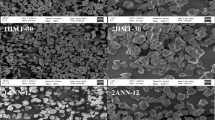Abstract
Native starch samples (corn, rice, and tapioca starches) were prepared in an aqueous slurry and dough system, and their functional properties were evaluated in terms of thermal and rheological characteristics. The pasting property results of starch slurries showed that rice starch exhibited the lowest peak temperature, whereas the highest peak viscosity was observed in tapioca starch. When starch suspensions were subjected to dynamic oscillatory temperature sweep testing, the increased storage moduli and reduced tan δ derived from starch gelatinization were clearly observed in all starch samples, showing that the gelatinized starch granules became more elastic. Steady shear measurements revealed the shear-thinning behaviors of starch pastes, which were dominant in tapioca starch, compared to the other starches. In addition, the distinct endothermic peaks of starch gelatinization were observed at 73.15, 62.25, and 70.55°C for corn, rice, and tapioca starches, respectively and these trends were in good agreement with the pasting and viscoelastic results. However, upon incorporation of the native starches to a wheat dough system, the highest dough consistency during heating and cooling was observed in corn starch probably due to the rigidity of its particle. Thus, the physicochemical response of native starches to temperature appeared to be different in different concentration regimes.
Similar content being viewed by others
References
Aggarwal P, Dollimore D, and Heon K (1997) Comparative thermal analysis study of two biopolymers, starch and cellulose. J Therm Anal 50, 7–17.
Fennema OR (2007) In Food Chemistry, (4th ed). Marcel Dekker Inc., USA.
Kahraman K, Sakiyan O, Ozturk S, Koksel H, Sumnu G, and Dubat A (2008) Utilization of mixolab to predict the suitability of flours in terms of cake quality. Eur Food Res Technol 227, 565–70.
Kang HJ, Hwang IK, Kim KS, and Choi HC (2003) Comparative structure and physicochemical properties of ilpumbyeo, a high-quality japonica rice, and its mutant, suweon 464. J Agr Food Chem 51, 6598–603.
Li JY and Yeh AI (2001) Relationships between thermal, rheological characteristics and swelling power for various starches. J Food Eng 50, 141–48.
Lii C-Y, Shao Y-Y, and Tseng K-H (1995) Gelation mechanism and rheological properties of rice starch. Cereal Chem 72, 393–400.
Mathew R (2007) The RVA handbook. J Texture Stud 38, 755–56.
Ratnayake WS and Jackson DS (2007) A new insight into the gelatinization process of native starches. Carbohydr Polym 67, 511–29.
Shi XH and BeMiller JN (2002) Effects of food gums on viscosities of starch suspensions during pasting. Carbohydr Polym 50, 7–18.
Steeneken PAM (1989) Rheological properties of aqueous suspensions of swollen starch granules. Carbohydr Polym 11, 23–42.
Thomas DJ and Atwell WA (1998) In Starches. Eagan Press, USA.
Author information
Authors and Affiliations
Corresponding author
Rights and permissions
About this article
Cite this article
Kim, Y., Yoo, SH., Park, KH. et al. Functional characterization of native starches through thermal and rheological analysis. J Korean Soc Appl Biol Chem 55, 413–416 (2012). https://doi.org/10.1007/s13765-012-2002-z
Received:
Accepted:
Published:
Issue Date:
DOI: https://doi.org/10.1007/s13765-012-2002-z




